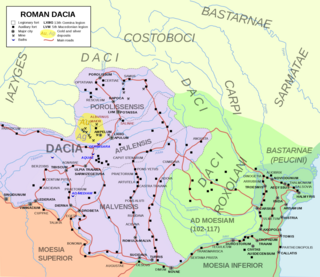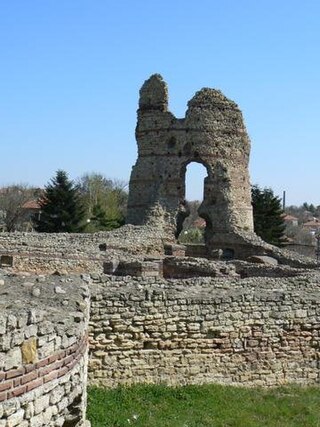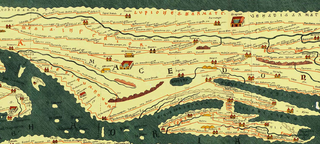
In the Roman Republic and the Roman Empire, the Latin word castrum was a military-related term.

Sucidava was a Dacian and Daco-Roman city situated in Corabia, Romania, on the north bank of the Danube. It developed from the 270s AD and especially after the construction of Constantine's Bridge the northern side of which it protected.

Castra Praetoria were the ancient barracks (castra) of the Praetorian Guard of Imperial Rome.

The Second Roman–Dacian War was fought between 105 and 106 because the Dacian king, Decebalus, had broken his peace terms with the Roman Emperor Trajan from the First Dacian War.

Located in Roman province of Dacia, present-day Romania, the Limes Porolissensis was a frontier of the Roman empire in Dacia Porolissensis, the northernmost of the three Dacian provinces. It was a defensive line dating from the 2nd century AD after the Conquest of Dacia. The frontier was a complex network of over 100 observation towers, fortlets, walls and forts disposed in a line over 200 km from the Apuseni Mountains to the Eastern Carpathians, following the highland chain of the Meseș Mountains.

Kula is a town in northwestern Bulgaria. It is the administrative centre of Kula Municipality part of Vidin Province. Located just east of the Serbian-Bulgarian border, it is the third largest town in the province after Vidin and Belogradchik. Kula lies 30 kilometres west of Vidin and 13 kilometres east of the border checkpoint at Vrashka Chuka. As of 2021, the town has a population of 2,400 inhabitants.

The Limes Alutanus was a fortified line consisting of a vallum, built in the North-South direction, on the eastern side of the Olt river and seven Roman castra, as is remembered by Tabula Peutingeriana. Limes Alutanus was the eastern border of the Roman province of Dacia Superior.

Claustra Alpium Iuliarum was a defense system within the Roman Empire between Italia and Pannonia that protected Italy from possible invasions from the East. It secured the Postojna Gate, the land link between the eastern and western part of the empire, and thus the Claustra represented an inner border defense of the empire. Unlike a linear rampart, the Claustra consisted of a series of interconnected fortifications with its center at Castra ad Fluvium Frigidum ; other important fortresses were Ad Pirum on today's Hrušica Plateau and Tarsatica, now a part of the city of Rijeka. They had been governed from the town of Aquileia.
Dacica is a Latin work by Roman Emperor Trajan, written in the spirit of Julius Caesar's commentaries like De Bello Gallico, and describing Trajan's campaigns in Dacia.

Aizis was a Dacian town mentioned by Emperor Trajan in his work Dacica. Located at Dealul Ruieni, Fârliug, Caraș-Severin, Banat, Romania.

Castra Buridava was a fort in the Roman province of Dacia.
Castra Traiana was a fort in the Roman province of Dacia.

The castra of Orheiu Bistriței was a fort in the Roman province of Dacia. It was built in the 2nd century AD. Archaeological research also identified the nearby vicus. The castra and the nearby settlement were both abandoned in the 3rd century AD. The ruins of the fort are located in Orheiu Bistriței.
The castra of Crâmpoia was a fort in the Roman province of Dacia. It was made of earth in the 2nd century AD. The Romans abandoned the fort in the 3rd century. Its ruins are located in Crâmpoia, Romania.
The castra of Fâlfani was a fort built in the 2nd century AD in the Roman province of Dacia. It was abandoned in the 3rd century. Its ruins are located on a hill in Fâlfani.
The castra of Livezile was a castra in the Roman province of Dacia, located in the north side of the modern commune of Livezile in the historical region of Transylvania, Romania. The fort was erected and surrounded by a ditch in the 2nd century AD. The castra was abandoned in the 3rd century and its ruins are still visible.

Although not unanimously accepted, the existence of the castra of Cristești in the Roman province of Dacia is substantiated by bricks and tiles bearing the name of a Roman military unit, the Ala I Gallorum et Bosporanorum. The lack of any other traces of the Roman fort may easily be due to its destruction by the Mureș River. At Cristeşti, a Roman settlement from the 2nd and 3rd centuries AD was unearthed which was an important center of potters.

It was a fort in the Roman province of Dacia.

Castra ad Fluvium Frigidum, also simply Castra, referred to as mutatio Castra in Itinerarium Burdigalense, was a Late-Roman fortress (castrum) which constituted the centre of Claustra Alpium Iuliarum, an Ancient Roman defensive system of walls and towers stretching from the Gail Valley to the Učka mountain range. On its grounds, the Late Medieval market settlement of Ajdovščina developed.
This page is based on this
Wikipedia article Text is available under the
CC BY-SA 4.0 license; additional terms may apply.
Images, videos and audio are available under their respective licenses.















